I am cutting a cavity in aluminum with a necked 1/8” , 3flute, carbide endmill extending 1.6” beyond the collet nose. The actual flute length is ¼”.
I am having trouble with runout at the cutting tip, about .001” or more.
Neither shrink fit holders nor precision collets and tool holders make a difference.
The problem is the endmill itself. The manufacturers tolerance for the endmill runout is a max of .0005”. This is not so bad. The tolerance stackup for a 1.6” extension is the issue.
By trial and error, I can get the runout down to 2 or 3 tenths by rotating the endmill in a non-precision collet and testing with a tenth indicator in the mill spindle.
Does anyone make ER collets with the bore intentionally off center similar to some side lock endmill holders which are supposed to center your endmill when you tighten the setscrew?
Would it be possible to wire EDM a 3mm ER16 collet off center, and make it 1/8 “ diameter?
I am having trouble with runout at the cutting tip, about .001” or more.
Neither shrink fit holders nor precision collets and tool holders make a difference.
The problem is the endmill itself. The manufacturers tolerance for the endmill runout is a max of .0005”. This is not so bad. The tolerance stackup for a 1.6” extension is the issue.
By trial and error, I can get the runout down to 2 or 3 tenths by rotating the endmill in a non-precision collet and testing with a tenth indicator in the mill spindle.
Does anyone make ER collets with the bore intentionally off center similar to some side lock endmill holders which are supposed to center your endmill when you tighten the setscrew?
Would it be possible to wire EDM a 3mm ER16 collet off center, and make it 1/8 “ diameter?





